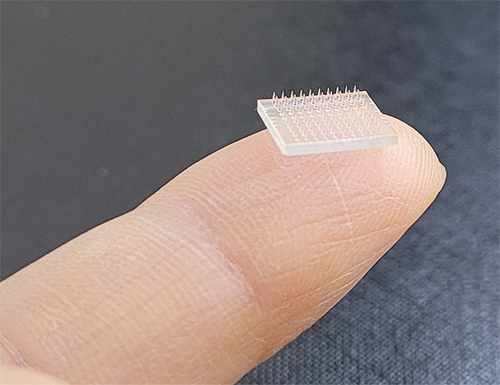| Sep 28, 2021 |
A 3D printed vaccine patch offers vaccination without a shot
|
|
(Nanowerk News) Scientists at Stanford University and the University of North Carolina at Chapel Hill have created a 3D-printed vaccine patch that provides greater protection than a typical vaccine shot.
|
|
The trick is applying the vaccine patch directly to the skin, which is full of immune cells that vaccines target.
|
|
The resulting immune response from the vaccine patch was 10 times greater than a vaccine delivered into an arm muscle with a needle jab, according to a study conducted in animals and published by the team of scientists in the Proceedings of the National Academy of Sciences ("Transdermal vaccination via 3D-printed microneedles induces potent humoral and cellular immunity").
|
|
Considered a breakthrough are the 3D-printed microneedles lined up on a polymer patch and barely long enough to reach the skin to deliver vaccine.
|
 |
| While microneedle patches have been studied for decades, the work by Carolina and Stanford overcomes some past challenges: through 3D printing, the microneedles can be easily customized to develop various vaccine patches for flu, measles, hepatitis or COVID-19 vaccines. (Image courtesy of the researchers)
|
|
“In developing this technology, we hope to set the foundation for even more rapid global development of vaccines, at lower doses, in a pain- and anxiety-free manner,” said lead study author and entrepreneur in 3D print technology Joseph M. DeSimone, professor of translational medicine and chemical engineering at Stanford University and professor emeritus at UNC-Chapel Hill.
|
|
The ease and effectiveness of a vaccine patch sets the course for a new way to deliver vaccines that are painless, less invasive than a shot with a needle and can be self-administered.
|
|
Study results show the vaccine patch generated a significant T-cell and antigen-specific antibody response that was 50 times greater than a subcutaneous injection delivered under the skin.
|
|
That heightened immune response could lead to dose sparing, with a microneedle vaccine patch using a smaller dose to generate a similar immune response as a vaccine delivered with a needle and syringe.
|
|
While microneedle patches have been studied for decades, the work by Carolina and Stanford overcomes some past challenges: through 3D printing, the microneedles can be easily customized to develop various vaccine patches for flu, measles, hepatitis or COVID-19 vaccines.
|
Advantages of the vaccine patch
|
|
The COVID-19 pandemic has been a stark reminder of the difference made with timely vaccination. But getting a vaccine typically requires a visit to a clinic or hospital.
|
|
There a health care provider obtains a vaccine from a refrigerator or freezer, fills a syringe with the liquid vaccine formulation and injects it into the arm.
|
|
Although this process seems simple, there are issues that can hinder mass vaccination – from cold storage of vaccines to needing trained professionals who can give the shots.
|
|
Meanwhile, vaccine patches, which incorporate vaccine-coated microneedles that dissolve into the skin, could be shipped anywhere in the world without special handling and people can apply the patch themselves.
|
|
Moreover, the ease of using a vaccine patch may lead to higher vaccination rates.
|
How the patches are made
|
|
It’s generally a challenge to adapt microneedles to different vaccine types, said lead study author Shaomin Tian, a researcher in the Department of Microbiology and Immunology in the UNC School of Medicine.
|
|
“These issues, coupled with manufacturing challenges, have arguably held back the field of microneedles for vaccine delivery,” she said.
|
|
Most microneedle vaccines are fabricated with master templates to make molds. However, the molding of microneedles is not very versatile, and drawbacks include reduced needle sharpness during replication.
|
|
“Our approach allows us to directly 3D print the microneedles, which gives us lots of design latitude for making the best microneedles from a performance and cost point-of-view,” Tian said.
|
|
The microneedle patches were 3D printed at Carolina using a CLIP prototype 3D printer that DeSimone invented and is produced by CARBON, a Silicon Valley company he co-founded.
|
|
The team of microbiologists and chemical engineers are continuing to innovate by formulating RNA vaccines, like the Pfizer and Moderna COVID-19 vaccines, into microneedle patches for future testing.
|
|
“One of the biggest lessons we’ve learned during the pandemic is that innovation in science and technology can make or break a global response,” DeSimone said. “Thankfully we have biotech and health care workers pushing the envelope for us all.”
|

